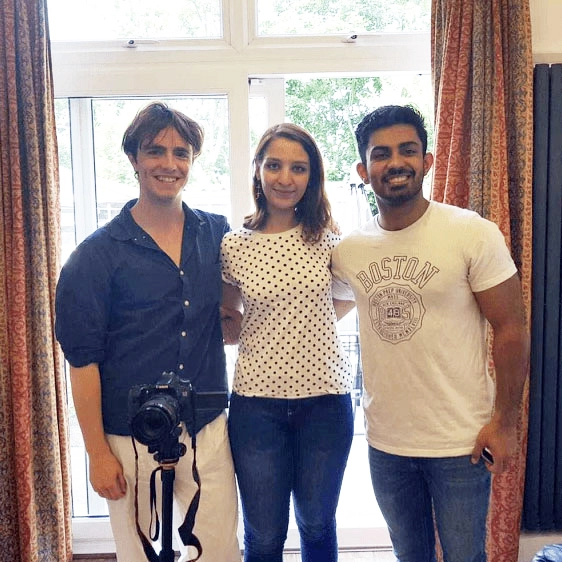Saadia Gardezi and her teammates at Project Dastaan use technology to help the Partition generation revisit the land of their birth.
By Shweta Bhandral
Jinne Lahore ni wakheya o jamiya ni (one who has not seen Lahore is not born). Saadia Gardezi grew up in Lahore, a city of history, art, culture, and literature. “Working with people who migrated between India and Pakistan in 1947, I cannot imagine how heart-wrenching it would be to leave home for good, especially a home like Lahore,” says the co-founder of Project Dastaan, a unique initiative that uses technology to help the Partition generation revisit the land of their birth.
A journalist who has worked for several news networks and a political cartoonist for The Nation in Pakistan, Saadia is also an artist and runs her own art studio called Penguin Pop. The 34-year-old’s vibrant sense of colour turns shoes, jackets, and bags into something unique and quirky. At present, she is pursuing her PhD in international relations at Warwick University, UK.
Earlier, as a Weidenfeld-Hoffmann Scholar at Oxford University in 2017, Saadia and her friends sowed the seeds of Project Dastaan. Their mission is to give emotional closure to a generation living with broken memories of the most challenging times of their lives.

Saadia explains, “Project Dastaan came into being when Indian and Pakistani friends studying in Oxford spoke to each other about the difficulty of being able to help their grandparents travel across the border. Due to wars, old age, and trauma, there are still too many barriers for this generation to return to see their ancestral villages, whether in India or Pakistan. Project Dastaan could make that return possible.”
With founder Sparsh Ahuja and co-founders Sam Dalrymple and Saadia Gardezi, the initiative aims to examine and document the human impact of global migration through the lens of the largest forced migration in recorded history, the 1947 Partition of India and Pakistan.
The project works at four levels. First is the social-impact programme that reconnects Partition survivors with their childhood homes. Saadia shares, “We aim to find the exact locations and memories that these survivors seek to revisit and recreate them through bespoke 360VR experiences.”

The second is A Child of Empire, an animated virtual-reality documentary that makes you experience a migrant’s state of mind. The Lost Migration is a three-part series sharing lesser-known Partition narratives and the impact of colonialism. Where Birds Live is a 40-minute documentary of a family from Pakistan visiting their ancestral home in Sherkot, India.
About the hurdles they faced in launching the project, Saadia says, “Strangely, it is only a reality because of the hurdles that exist in the path of free movement and collaboration between the two nations. The wired borders and hostilities between the two countries have created visa regimes that can only be described as cruel when considering the shared heritage. These political narratives have created enmity between people resulting in misinformation and hate without the chance of physical contact with the other. It is only contact that can help remove our misconceptions. Project Dastaan tries to establish the fact of our ‘contact’ in the past… a shared past.”
The younger generation has the power to look at the situation from a new perspective. Saadia proudly talks about the Project Dastaan team who believe in the vision and are willing to go out in the field.

“Jayosmita Ganguly in India and Ayesha Mir in Pakistan are two writers and filmmakers who have given us exceptional support. In early 2020, we ran a kickstarter campaign, and through the support of donors in India, Pakistan, and across the world we raised $28,000.”
The project is supported by Catchlight, The National Geographic, St Edmund Hall at Oxford University, and the British Council’s Digital Collaboration Fund, and a group of advisors including Malala Yousafzai, Anita Irani, Aanchal Malhotra, Anam Zakaria, and Dr Yasmin Khan.
The team hopes that such a grassroots movement can help people in India, Pakistan and Bangladesh think of each other as human, equal, and worthy of love and hospitality.

Saadia shares that the most touching moment is when the whole family feels reconnected to their roots: “The families’ reaction to the footage has often been even more exuberant than the survivors’. In a way, we have been able to reconnect whole families to their ancestral towns and villages. The use of the virtual-reality medium has been a great catalyst for young people to start having conversations with older generations about history and Partition.”
Talking about Indo-Pak peace, Saadia admits there is a long way to go. Still, she believes that there are pockets of hope, building harmony amongst people. She believes, “The opening of the Kartarpur Corridor was one such spark that allowed for open exchange between people, but such official overtures of friendships are few and far between. Meanwhile, it seems it is up to Indians and Pakistanis themselves to think about peace, to find common ground, and change our habitual kneejerk reaction of wanting to criticise and disparage anything associated with the other.”
Saadia has a list of places that she wants to visit in India. She says, “Sadly, I have not been to India; I could not secure a visa. But I do not doubt that it will feel something a lot like home.”
First published in eShe’s February 2021 issue
Syndicated to Money Control

